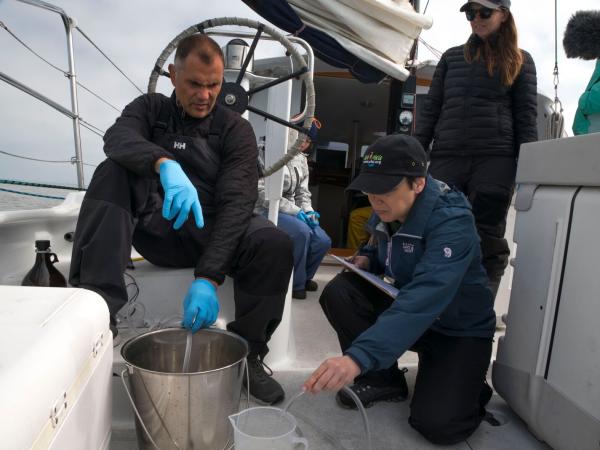Workgroups
Projects Related to the Workgroups
 Statewide Plastics Monitoring Plan & Strategy
Statewide Plastics Monitoring Plan & Strategy
Plastics, in their various chemical composition and sizes, pose serious challenges to the vitality of California's ecosystems. Once escaped into the environment, plastic contamination persists for very long periods and breaks down into ever smaller pieces, becoming more readily available to wildlife and populations who live, work, and play in those same habitats.
 California Pesticides: A Data Visualization Tool to Link Pesticide Use and Management to Water Quality
California Pesticides: A Data Visualization Tool to Link Pesticide Use and Management to Water Quality
Despite California's data-rich environment, there are still many obstacles when trying to access and understand pesticide data at the nexus of water quality, ecological effects, and human health. We recognize a need to fill data gaps, not necessarily by collecting new data, but by better leveraging information already technically in the public domain. The goal of this project is to bring pesticide reporting, occurrence, and toxicity data together in ways that yield insights and meet the expressed needs of stakeholders in clear, efficient, credible, and repeatable ways.
 Perfluoroalkyl and Polyfluoroalkyl Substances (PFAS)
Perfluoroalkyl and Polyfluoroalkyl Substances (PFAS)
A recent analysis of PFAS in the surface waters of SF Bay was conducted to understand the occurrence, fate, and potential risks to ecological and human health. Eleven of 40 PFAS were detected at part per trillions (ppt) concentrations in ambient water collected in 2021 from 22 sites in the Bay. Seven PFAS (PFPeA, PFHxA, PFHpA, PFOA, PFBS, PFHxS, and PFOS), were found in at least 50% of samples. Concentrations of PFAS in the Bay were generally consistent with similar studies globally for surface water. Sustained, multi-matrix monitoring of this important class of contaminants of emerging concern is a high priority for the RMP.
 Microplastic Pollution in San Francisco Bay
Microplastic Pollution in San Francisco Bay
Plastic pollution is gaining global recognition as a threat to the resilience and productivity of ocean ecosystems. However, we are only just beginning to understand the scope and impacts of microplastic particles (less than 5 mm) on coastal and ocean resources, and the San Francisco Bay Area is no exception. A preliminary study of nine water sites in San Francisco Bay, published in 2016, showed greater levels of microplastics than the Great Lakes or Chesapeake Bay.
 Contaminants of Emerging Concern Strategy
Contaminants of Emerging Concern Strategy
More than 100,000 chemicals have been registered or approved for commercial use in the US. For many of these chemicals, major information gaps limit evaluations of their potential risks, and environmental monitoring of these chemicals has not been required by regulatory agencies. Nevertheless, researchers and government agencies have begun to collect occurrence, fate, and toxicity data for a number of these chemicals.
Publications related to the Workgroups
The Institute has collectively produced more than 1300 reports, articles, and other publications over the course of its 24-year existence. The following list represents those publications associated with this individual program and its focus areas.
Nothing found
Year of Publication: 2018
. Estrogen Receptor In Vitro Assay Linkage Studies. Richmond, CA: San Francisco Estuary Institute ; 2018 . Report No.: 888.  (1.8 MB)
(1.8 MB)
. Guadalupe River Mercury Concentrations and Loads During the Large Rare January 2017 Storm. Richmond, CA: San Francisco Estuary Institute ; 2018 . Report No.: 837.  (2.53 MB)
(2.53 MB)
. Gut Contents Analysis of Four Fish Species Collected in the San Leandro Bay RMP PCB Study in August 2016. Richmond, CA: San Francisco Estuary Institute; 2018 . Report No.: 900.  (1.76 MB)
(1.76 MB)
. Non-Targeted Analysis of Water-Soluble Compounds Highlights Overlooked Contaminants and Pathways (Coming Soon). Richmond, CA: San Francisco Estuary Institute; 2018 . Report No.: 905.
. North Bay Selenium Monitoring Design. Richmond, CA: San Francisco Estuary Institute ; 2018 . Report No.: 921.  (2.08 MB)
(2.08 MB)
. Per and Polyfluoroalkyl Substances (PFAS) in San Francisco Bay: Synthesis and Strategy. Richmond, CA: San Francisco Estuary Institute ; 2018 . Report No.: 867.  (3.2 MB)
(3.2 MB)
. Pollutants of Concern Reconnaissance Monitoring Water Years 2015, 2016, and 2017. Richmond, CA: San Francisco Estuary Institute; 2018 . Report No.: 840.  (5.55 MB)
(5.55 MB)
. RMP Small Tributaries Loading Strategy: Modeling and Trends Strategy 2018. Richmond, CA: San Francisco Estuary Institute ; 2018 . Report No.: 886.  (1.3 MB)
(1.3 MB)
. Selenium in Muscle Plugs of White Sturgeon from North San Francisco Bay, 2015-2017. Richmond, CA: San Francisco Estuary Institute ; 2018 . Report No.: 929.  (2.24 MB)
(2.24 MB)
. Selenium in White Sturgeon from North San Francisco Bay: The 2015-2017 Sturgeon Derby Study - (Coming Soon). Richmond, CA: San Francisco Estuary Institute ; 2018 . Report No.: 897.
. Statistical Methods Development and Sampling Design Optimization to Support Trends Analysis for Loads of Polychlorinated Biphenyls from the Guadalupe River in San Jose, California, USA. Livermore, CA: Applied Marine Sciences; 2018 . Report No.: 876.  (1.76 MB)
(1.76 MB)
Year of Publication: 2017
. Assessing the Impact of Periodic Dredging on Macroinvertebrate-Prey Availability for Benthic Foraging Fishes: Final Study Plan and Preliminary Pilot Study Results. Vallejo, CA: U.S. Geological Survey; 2017 . Report No.: 833.  (1.88 MB)
(1.88 MB)
. Changing Channels: Regional Information for Developing Multi-benefit Flood Control Channels at the Bay Interface. Flood Control 2.0. Richmond, CA: San Francisco Estuary Institute; 2017 . Report No.: 801.  (62.69 MB)
(62.69 MB) (23.02 MB)
(23.02 MB)
. Characterization of Sediment Contamination in Central Bay Margin Areas. Richmond, CA: San Francisco Estuary Institute; 2017 . Report No.: 829.  (2.89 MB)
(2.89 MB)
- ‹ previous
- 8 of 14
- next ›
